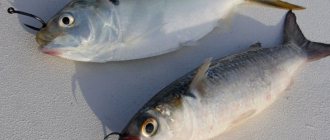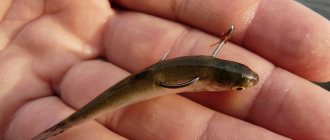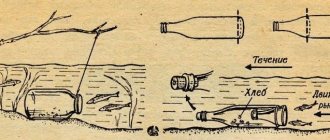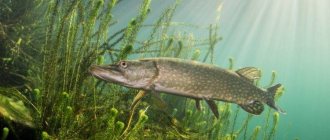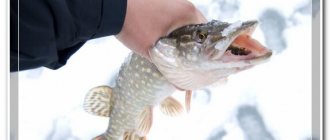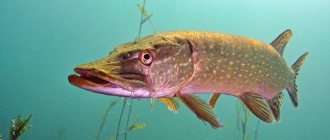The topic describes several of the most popular live baits, which are considered for one quality or another the best and most often used for catching pike and pike perch with winter baits.
Many urban fishermen, to install winter girders on the first ice, stock up on live bait before the freeze-up and store small fish for quite a long time at home - usually on the balcony - in a container with chilled water, which is changed periodically.
I would classify the best live bait fish as crucian carp - a fairly tenacious live bait, often used for filling the winter bait for pike, but which is difficult to catch in winter. As live bait for catching pike perch, fish with a narrow body structure are usually placed on the hooks of girders.
Live bait for winter bait
Small representatives of a wide variety of fish are used as live bait for winter bait intended for catching pike perch and pike perch. But the best bait for attaching to the tee of a girder is considered to be the live bait that is included in the daily winter diet of predatory fish in a particular reservoir.
Most often pike are interested in live bait during winter fishing, much less often - pike perch and large perch; it happens that burbot is caught using live bait gear.
Taking into account the specifics of winter fishing for burbot with live bait, it does not have to be a girder with a reel-to-reel line spreader. Many fishermen consider the ruffe to be the best live bait for catching burbot.
Depending on the method of filling the winter bait with bait and the convenience of catching small fish in a particular body of water, each fisherman can have his own “favorite” live bait, including minnows.
To refuel winter baits for pike, some fishermen believe that there is nothing better than medium-sized crucian carp, and to catch large perch using a jig with fry, they prepare top-smelting fish.
Although, often during winter fishing, when there is no bite, the pike raises a flag on a girder filled with a not so large topwater. Undoubtedly, pike perch will not refuse such live bait on the winter bait.
But the best universal live bait for refueling winter and summer baits for catching pike, pike perch, and burbot is considered to be a gudgeon, which you can sometimes buy in specialized stores before fishing. And it seems that for this reason the gudgeon population in many small rivers is not declining.
In principle, any fish that has long survivability on the hook is suitable for pike as live bait, both in winter and summer fishing.
Just don’t forget about one feature of the life of predatory inhabitants of winter reservoirs. By spring, the abdominal cavity of most fish becomes filled with eggs.
Therefore, if the pike does not disdain relatively large bream on the first ice, then in order to fill the girders for the pike by the end of the winter season, it is better to catch before or directly during fishing more compact live baits of not such a wide shape.
Storage while fishing in cold weather
For those who often fish with live bait, it is simply necessary to acquire a canoe. A very convenient device in which the fry can be easily transported and stored while fishing. The internal mesh allows you to avoid getting your hands wet while catching live bait.
If you don’t have such a device, then snow will help. It is known to retain heat well. To prevent the water in the bucket from freezing, place it in a snowdrift.
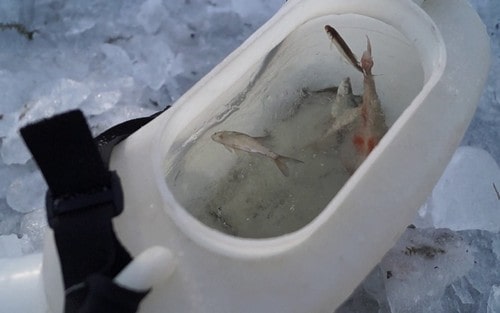
Another proven method is in a plastic bottle under ice. Make small holes in the container and lower it into the water on a rope.
The diameter of a 1.5-liter plastic bottle is ideal for the size of the hole. When fishing with girders, a 150 mm ice screw is used. Read this article about how to choose a tool.
The question of how to preserve live bait in the winter at home and in the pond is relevant for many fans of ice fishing for girders. Now there shouldn't be any difficulties. It is not always possible to obtain it locally. Usually they are stocked up in the fall or purchased a few days before fishing. If you have your own storage method, please share it in the comments.
The best winter bait for pike perch
To catch pike perch with its small mouth cavity, it is better to fill a winter bait with live bait that has a narrow body.
The dace shown in the picture, along with small ide and gudgeon, are some of the best live bait for catching pike perch with girders, if you manage to get hold of representatives of these fish species in the winter season.
But, if you get on a school of pike perch in the flow of a large river, then the best live bait may be sprat, capelin, anchovy or sprat. In the evening, unsalted fish is transferred from the freezer to the refrigerator.
In the morning of winter fishing, you can install 2-3 gear on the ice. True, to catch pike perch on the river flow you have to set up winter fishing rods with vertical rigs and good weight lead jigs. So, even if you want to, the gear cannot be called winter girders.
Yes, and thawed dead fish, which in the current can easily replace live small roach and verkhovka, are not exactly live bait, but you can’t explain this to a voracious pike perch.
By the way, don’t forget to put limit bars on fishing rods with nod rigs. Otherwise, catching pike perch with live bait can turn into too expensive winter fishing with gear diving under the ice.
Tackle
A tackle is a device for fishing with a spinning rod for a dead fish. Such natural bait, attached to a hook, attracts pike much better than any artificial one . Even edible rubber cannot compare with it - twisters and vibrating tails made of silicone, to which attractants are added.
The classic tackle consists of an eared sinker, to which a spacer and a treble hook on a metal leash are attached. The spacer is inserted into the mouth of the bait and securely fixes it, and the tee is attached to the tail part. Thus, the length of the leash on which the hook is attached must correspond to the size of the fish . You need to have several tackles in your arsenal for catching dead fish of various lengths.
There is also another version of this device. To make it, you need to add a second tee, which is attached to a short leash. It is inserted into the front of the fish's body. Thanks to the presence of a second hook, the chances of a successful hooking are significantly increased.
The rig very rarely today , but fishing with it brings very good results , so every spinning angler should try it.
Thus, there are many options pike baits Most anglers prefer live baits - they are easy to get, and fishing with them is quite simple. A live fish attached to a hook perfectly attracts pike at any time of the year. But it is worth paying attention to other baits.
Frogs, capelin, sprat, crayfish meat, pieces of fish, and shrimp can also bring good catches. The tackle will be an excellent replacement for artificial baits for spinning anglers . It’s worth trying, especially when the predator is inactive and refuses to take spinners, wobblers and silicone. In such cases, a rig can save the situation.
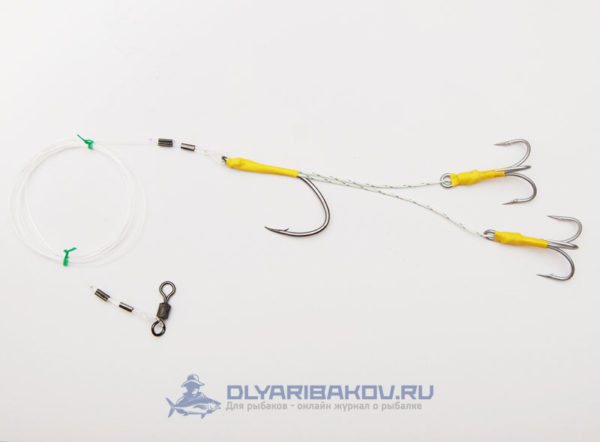
Universal live bait for gudgeon
A universal live bait for catching pike and pike perch - gudgeon is shown in the picture.
True, already at the beginning of the winter season, schools of minnows move from the sandbanks to deep river channels, where the water is somewhat warmer and the current is less than in the rifts.
For this reason, searching for and catching minnows on rocky and sandy soils of reservoirs is associated with certain difficulties and, often, not quite close to the winter vents installed on the ice.
And these are not the places where you can catch perch instead of minnows as live bait for winter fishing. More likely, the brush will fiddle with the nozzles.
Fishing for gudgeon for the gudgeon
Considering the light weight of such live bait, the best tackle for catching gudgeons are float or nodding winter fishing rods with light bottom sliding sinkers.
Hooks for catching minnows are tied on small dark ones, with an elongated shank, and the fishing line is set with a diameter of 0.1-0.12 mm. The best universal bait on hook No. 3-3.5 (according to Russian numbering) is 1-2 bloodworms.
Placing a gudgeon on a gudgeon hook
To catch pike perch in the winter gudgeon, a gudgeon is placed on a single hook, piercing both lips of the bait fish; for pike, it is better to use a double hook with good hardening.
Three to four dozen minnows as live bait for fishing for pike and pike perch can live in a wide basin at above-zero temperatures on a winter balcony for about a month without changing water or bait.
After refueling winter gudgeons while fishing, it is advisable to gradually change the water in small portions in the canna with the remaining live bait.
Making a zherlitsa with your own hands
Homemade girder
To make a classic girder for summer pike fishing with your own hands, prepare the following tools:
- wood hacksaw;
- hatchet;
- sharp knife;
- pliers.
Materials you will need:
- branch with several branches;
- monofilament line;
- lead sinker;
- metal leash;
- thin aluminum tubes;
- swivel;
- double hook.
The process of making a homemade girder:
- Possible options for homemade designs of vents
from a freshly cut alder or hazel branch, use a hacksaw to cut a strong slingshot 15-20 cm long; - in the upper part of the slingshot, use a knife to cut a circular groove, to which tie a strong nylon thread with any reliable knot;
- on one of the branches of the slingshot, closer to the fork, make another annular groove, tie the end of the fishing line to it;
- wind the fishing line tied to the slingshot around its branches in a figure eight;
- Place a sliding sinker of the “olive” type on the fishing line;
- make a double loop at the end of the wound fishing line;
- to make a leash, take a thin and flexible copper or steel string, put a thin aluminum tube on it, then pass the tip into one of the ears of the swivel and thread it into the tube again;
- using pliers, crimp the tube, giving the swivel attachment to the leash strength and mobility;
- cut off the excess amount from the string so that the length of the leash is no more than 30 cm;
- at the other end of the leash, repeat a similar operation with the tip of the string and the tube with the difference that instead of a swivel, fasten a double hook on it;
- Tie the finished metal leash to the fishing line with a loop-to-loop knot;
- At the end of any of the slingshot branches, use a knife to make a small split, which will later serve to fix the line of the charged rod.

The process of making a zherlitsa with your own hands
Roach for winter fishing for pike and pike perch
The second most important, but also the best universal live bait for catching pike perch and pike with winter or summer bait, many fishermen rightly consider roach.
In cold water, a roach carefully placed behind its back can be active on the hook of live bait gear for a long time.
But unlike live bait - perch, gudgeon and ruffe, roach on the hook of a winter girdle tends to go to the upper layers of the water, sometimes entangling the incorrectly assembled equipment.
And catching roach, sensitive to weather changes, near the installation of winter girders is not always successful: either due to the lack of appetite of this live bait, or due to changes in the stopping places of schools of small fish. Ruff and small perch are caught much more often.
Therefore, some fishermen fill winter fishing rods for pike perch and pike with roach caught the day before fishing in the body of water closest to their home. And it’s better to start fishing for roach a day or two before going fishing. True, few winter fishermen have such opportunities.
In terms of versatility, roach is equally well suited for winter fishing for both pike perch and pike perch.
Usually, roaches are caught during winter fishing near winter girders installed on the ice, which are first loaded with fish of any breed. Then, as the eland accumulates live bait, they replace the fish that have fallen asleep on the hooks of the girders with roach, fresh perch, or even large ruff.
At the beginning of winter, schools of roach visit the coastal zone with a sandy bottom and islands of reeds and reeds frozen into the ice, where baitfish can still get hold of winter live food.
This is the best time both for catching roach as live bait, and for predatory fish with winter girders as a catch. As the ice grows, the roach moves out of the shallow waters. It is clear that the incentive for pike perch and pike to visit shallow waters disappears.
To catch roach using bloodworms in reservoirs without a current, use a thin line with a small hook on the tackle. Finely chopped baked goods soaked in a hole will significantly speed up the capture of live bait for winter baits.
Breadcrumbs, oatmeal, milk powder, egg powder, and semolina are also used to feed small roaches.
The bait of a single fresh bloodworm is considered a universal bait for catching small roach for girders throughout the winter.
Bait for self-catching girder
And now another important point. The finished flyer must be hung from a pole in the chosen place, and then baited with small fish, preferably crucian carp for the summer, since crucian carp is incredibly tenacious.
And although pikes don’t always like it, they nevertheless take it for crucian carp almost everywhere. Even if roach is a more familiar and attractive prey for pike and perch, these fish remain much less tenacious on a hook than crucian carp.
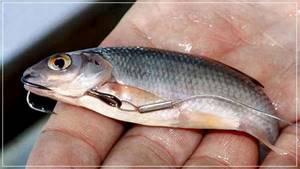
The pole is placed at an angle of 45 degrees, and with a very long pole the angle can be made even sharper. This will ensure that the bait will not get caught on the pole.
You can stick it directly into the grass, and the live bait will then be located along the edge of the vegetation, without touching it and without being able to hide in it from the sharp-eyed pike.
The most successful places for installing fliers are windows or long passages, among grass or dense thickets of reeds. Strips of grass along the shoreline are also catchy, even if it is shallow.
And the largest pike goes out in the mornings and evenings into the grassy pools near the shore, where the water boils from the melting small fish.
Perch - winter bait fish for pike
Perch can hardly be called the best live bait, but in many closed-type reservoirs, perch is the few, if not the only, representative of cold-blooded fish that can be used to load winter fishing rods for catching pike.
During the winter, you can guess at several periods when the pike has a real hunger for winter baits, but catching live bait from representatives of the “white fish” can be very problematic at this time.
But you can catch small perches in the shallows for equipping the tees of winter girders for catching pike with red-finned live bait without much difficulty.
The good thing about perch as live bait is that it tends to go to the bottom of the reservoir. Therefore, fishermen practically never have problems with fishing line tangling on a winter fishing line when fishing for pike with live bait. In addition, perch, unlike roach, lives for quite a long time when wounded by a hook.
When catching pike with winter and summer poles (circles, stands) near snags, one should not forget that even small perch set as live bait is also a predator, and therefore tends to go into cover with the threat of snagging the tackle for catching pike with live bait in snags or grass.
For the winter season, grass perch is a good, if not the best, live bait for pike fishing gear installed on the ice of rivers and reservoirs. The fish lives a long time, perch is faster than other small fish and can be caught in almost any winter body of water.
Small specimens of perch no larger than 40-50 grams in weight are suitable as live bait for filling winter baits for pike. Larger live baits, tearing off the signal flags of winter vents from the stoppers, can force the fisherman to run around a lot in vain.
In most reservoirs, catching small perch in the first half of winter does not present any difficulties. Perch gathered in fairly large schools can be found in the coastal zone at a meter depth.
In the same places, mixed with perch, ruffe, roach and other live bait fish of the carp family are caught using bloodworms. So, as a rule, there are no problems associated with filling winter girders with perch and roach.
The best places to live and catch small perch in winter reservoirs are sandbanks, island slopes, thickets of dry reeds, reeds, and snags in shallow water.
Therefore, some fishermen fill their winter pike baits with quickly caught perch, and then during the day, in the absence of pike bites, gradually replace the perch with a roach (roach) caught by this time with bloodworms.
Problems in finding and catching perch, as live bait intended for filling winter vents, arise during the dead winter period in closed reservoirs. But pike, a hardy fish, also feels unwell at this time and becomes passive.
